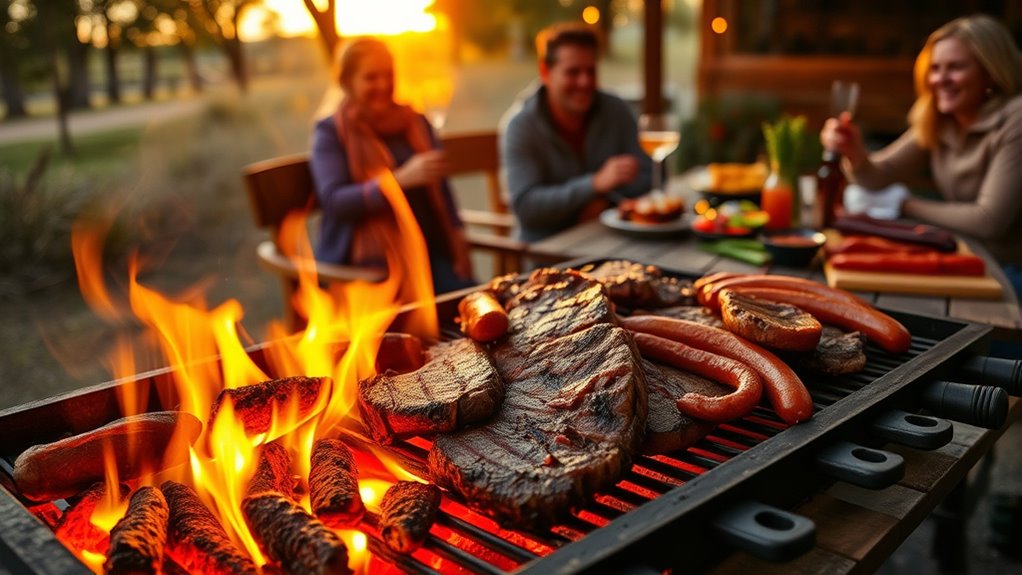Argentinian asado is more than just grilling meat—it’s a cultural craft that combines mastery of fire, traditional techniques, and community spirit. By managing heat carefully and knowing when to turn the meat, you can reveal rich, smoky flavors with tenderness and juiciness. Paired with fresh chimichurri, this process showcases Argentina’s pride and heritage. The unique artistry of asado invites you to explore its deep-rooted traditions—there’s always more to uncover behind each flavorful bite.
Key Takeaways
- Argentinian Asado is a cultural tradition emphasizing mastery of fire and precise grilling techniques.
- It involves traditional skills passed down through generations, highlighting craftsmanship and authentic flavor.
- Chimichurri sauce enhances grilled meats, reflecting the importance of fresh, herbaceous accompaniments.
- Asado is a social event that fosters community, pride, and sharing stories alongside cooking.
- The practice elevates simple cuts into culinary art, showcasing Argentina’s unique barbecue heritage.

Have you ever wondered what makes an Argentinian Asado so special? It’s more than just grilling meat; it’s an art form that combines skill, tradition, and a deep appreciation for shared moments. At the heart of it all are the grill master techniques that transform simple cuts of beef into a culinary masterpiece. Asado isn’t just about cooking; it’s about mastery. You learn to read the fire, control the heat, and time everything perfectly. The grill master’s approach involves understanding the different types of fire—whether you’re working with hot coals or a slow-burning wood—and knowing exactly when to turn and move the meat for that ideal smoky flavor and tender texture. Patience is key, and the best grill masters develop a keen sense of timing, ensuring that every cut of meat reaches its peak juiciness without overcooking. These techniques, passed down through generations, elevate the experience from ordinary barbecue to an authentic Argentine tradition. Additionally, the use of specific fire management methods enhances the flavor and tenderness of the meat, showcasing the importance of traditional skills in the craft. Complementing the grilling skills is the traditional chimichurri, a vibrant green sauce that’s essential to any true Asado. It’s made with fresh parsley, garlic, oregano, vinegar, olive oil, and a touch of red pepper flakes, creating a tangy, herbaceous burst of flavor that enhances the richness of the meat. When you prepare chimichurri, you’re not just making a condiment; you’re embracing a cultural ritual. The sauce is often made fresh, allowing the herbs to release their full aroma and flavor, and it’s typically served alongside the meat right off the grill. The combination of perfectly grilled meat and this zesty sauce is what defines the Argentine approach to barbecue. It’s all about balancing bold flavors with simplicity, letting the quality of the meat shine while adding a fresh, herbal dimension that cuts through the richness. Asado is more than just a meal; it’s a social event where skills are shared, stories are exchanged, and traditions are celebrated. Whether you’re mastering the grill or preparing the perfect chimichurri, every step is infused with a sense of pride and a desire to honor the cultural roots behind this iconic Argentine practice. When you understand these elements—your grill master techniques and the authentic chimichurri—you’re not just cooking; you’re participating in a centuries-old tradition that’s deeply woven into the fabric of Argentine life. It’s this blend of skill, flavor, and community that makes an Argentinian Asado truly unforgettable.
Frequently Asked Questions
What Are the Traditional Side Dishes Served With Argentinian Asado?
You typically serve side dishes like provoleta cheese, which melts beautifully over the grill, alongside fresh salads. Chimichurri sauce is a must-have, adding vibrant flavor to the grilled meats. You might also enjoy crusty bread, grilled vegetables, or traditional potatoes. These sides complement the smoky, savory flavors of the asado, creating a well-rounded meal that highlights Argentinian barbecue culture and enhances your grilling experience.
How Do Argentinians Select and Prepare Their Wood or Charcoal?
You choose wood that whispers stories of the land, selecting seasoned, dense logs like quebracho or eucalyptus for rich flavor. For charcoal, you carefully prepare it by lighting and waiting until it’s glowing with a steady heat, like embers of passion ready to ignite. This thoughtful process guarantees your asado’s soul is infused, making every bite a fiery symphony of tradition and love.
What Is the Significance of the “Asador” in the Barbecue Process?
You’ll find that the asador plays a vital role in the barbecue process, acting as both a master griller and cultural symbol. They control grilling techniques, managing fire and heat to perfect the meat. Beyond cooking, the asador embodies tradition and community, showing respect for the craft and the gathering. Their skill and knowledge elevate the asado from a meal to a cultural experience, fostering connection and pride.
Are There Regional Variations in Argentinian Asado Styles?
You might think all Argentinian asados are the same, but regional variations truly shine through. Different areas bring unique flavors and cooking techniques, influenced by local ingredients and traditions. For example, in Patagonia, you’ll find a focus on game meats and slower cooking, while in Buenos Aires, beef cuts are celebrated with quicker, more intense flames. Embrace these regional flavors to experience the full richness of Argentine barbecue culture.
How Has Argentinian Asado Evolved With Modern Culinary Trends?
You see, Argentinian asado has evolved by blending traditional methods with modern culinary trends. You might notice fusion techniques, like incorporating international spices or innovative cooking styles, making the experience more gourmet. Chefs now experiment with gourmet influences, elevating classic cuts and presentation. This evolution keeps the tradition fresh, inviting new tastes while respecting the rich cultural roots of the asado, creating a dynamic and exciting culinary scene.
Conclusion
You now know that Argentinian asado isn’t just a meal—it’s a deep-rooted cultural tradition. Did you know that Argentina has over 10 million barbecue grills, showcasing how integral this practice is to daily life? Whether you’re grilling with friends or savoring the flavors of perfectly cooked meat, embracing asado connects you to a vibrant history. So, next time you light a fire, remember—you’re part of a rich, time-honored Argentine tradition.









